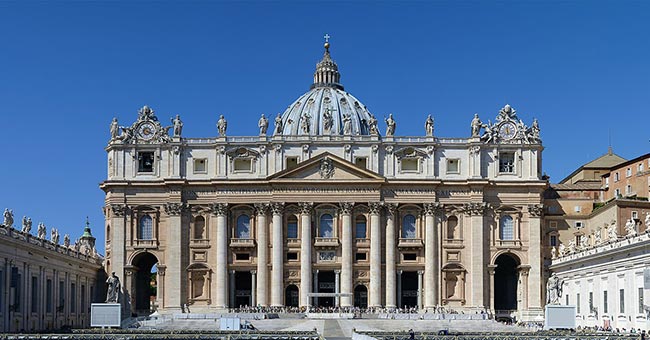St. Peter’s Basilica
St. Peter’s Basilica is one of the largest and most magnificent Christian churches in the world. It is located in Vatican City, an independent papal state within the city of Rome. This basilica is not only a symbol of Christianity but also a remarkable monument of human civilization, blending architecture, religious art, and history. It serves as the Pope’s principal place of worship and is a sacred destination for countless pilgrims.
History
The history of St. Peter’s Basilica stretches back to ancient Roman times. It is believed that in the 1st century AD, Saint Peter—one of the foremost apostles of Jesus and a leading figure in the spread of Christianity—was martyred in Rome and buried at the base of Vatican Hill. Later, Roman Emperor Constantine the Great, who legalized Christianity, built the first church over Peter’s tomb in AD 326. This original structure became known as the “Old St. Peter’s Basilica.”
By the early 16th century, the old basilica had deteriorated. In 1506, Pope Julius II ordered the construction of a new, larger basilica. The project took about 120 years to complete and was finished in 1626 during the papacy of Urban VIII.
Financing Through Indulgences
One controversial method of financing the new basilica was the granting of indulgences in exchange for donations. Archbishop Albrecht of Mainz and Magdeburg played a key role in this fundraising effort, as he needed to repay debts to the Roman Curia from his contributions to the reconstruction project. To facilitate this, he appointed the German Dominican preacher Johann Tetzel, whose aggressive selling methods sparked outrage and became one of the triggers for the Protestant Reformation.
Architectural Style
St. Peter’s Basilica is a masterpiece of Renaissance and Baroque architecture, designed and built by some of history’s most renowned artists and architects:
Donato Bramante – Initial design architect.
Raphael – Second-phase architect.
Michelangelo – Designed the dome.
Carlo Maderno – Created the façade and main entrance.
Gian Lorenzo Bernini – Contributed to the interior decoration and the design of the grand square in front of the basilica.
The dome, one of the most iconic landmarks in Rome, stands about 136 meters (446 feet) high with a diameter of 42 meters (138 feet). Visitors can climb nearly 500 steps to reach the top, where they are rewarded with sweeping views of Rome.
Main Features and Interior Beauty
The basilica’s grandeur is matched by its exquisite artworks and sacred spaces:
Michelangelo’s Pietà – A marble sculpture of the Virgin Mary holding the body of Jesus, located in a chapel near the entrance.
Main Altar (Baldachin) – A monumental bronze canopy by Bernini, positioned directly above Saint Peter’s tomb.
Confessio and Crypt – Believed to be the burial site of Saint Peter, where pilgrims gather for prayer.
Statue of St. Peter – A bronze statue whose right foot is traditionally touched or kissed by pilgrims seeking blessings.
St. Peter’s Square
In front of the basilica lies St. Peter’s Square (Piazza San Pietro), designed by Bernini. The square is framed by two semicircular colonnades that embrace visitors in a symbolic gesture of the Church’s welcome. At the center stands an ancient Egyptian obelisk, brought to Rome in antiquity.
Religious Importance
St. Peter’s Basilica is one of the four Major Basilicas of Catholicism and is considered the most important pilgrimage site for Catholics, even though the official cathedral of the Pope is the Lateran Basilica. Major religious events are often held here, such as:
Easter and Christmas Mass
The Pope’s first Mass after election
Various holy festivals and blessing ceremonies
Tourism and Cultural Influence
St. Peter’s Basilica is not only a sacred space but also a cultural landmark that draws millions of visitors each year. Entry to the basilica is free, though tickets are required to climb the dome. Its serene and reverent atmosphere offers visitors a deeply spiritual experience.
As a monument, St. Peter’s Basilica represents a timeless blend of faith, art, and architecture. Its dome offers breathtaking views of Rome, while every corner of its interior embodies a sense of divine inspiration and human craftsmanship.
References
Vatican.va
UNESCO World Heritage Centre
Britannica.com
Art History Textbooks on Renaissance and Baroque Architecture

